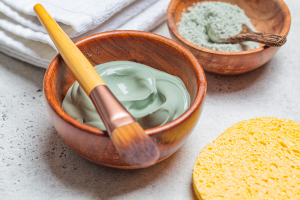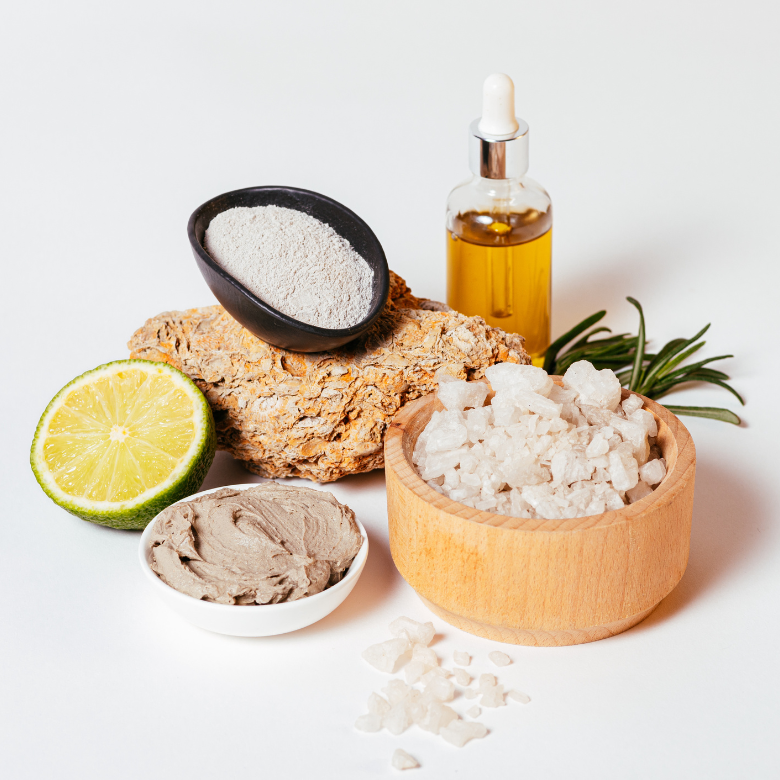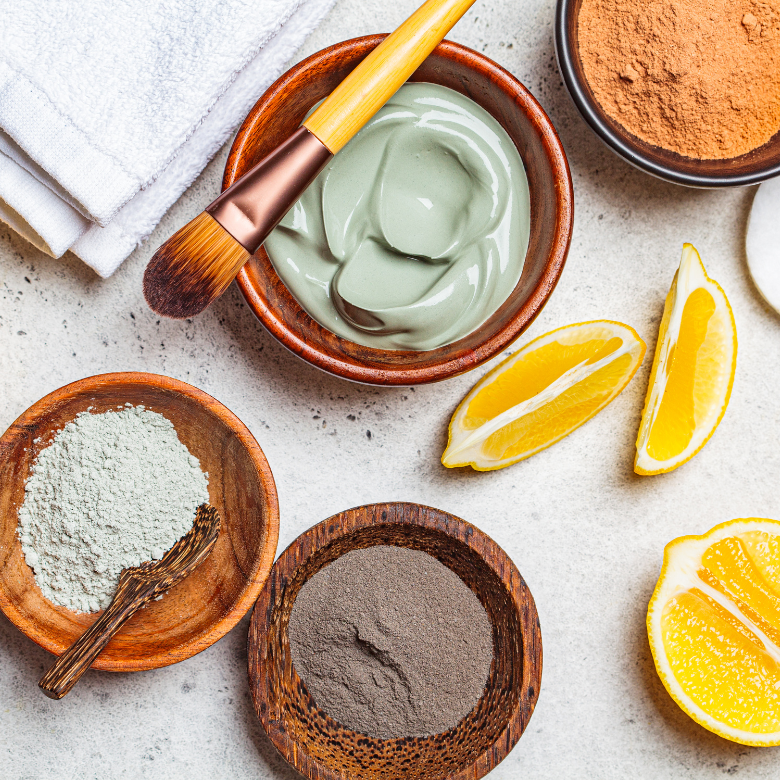Even though we have a significant number of methods and means of making cosmetics today, the most popular are natural raw ingredients. Consumers pay more and more attention to the composition of skin care products or choose to make them at home. This is how many people have realised the potential of cosmetic clays. Find out how beneficial they are!

What are clays and how to use them?
The popular clays are crystalline minerals composed of, among others, aluminium oxide, iron and silica. These natural ingredients come from geological processes that occur in nature, and are in clays that are extracted from the ground.
The effectiveness of masks and other cosmetics with added clays is as high as it is because of numerous properties exhibited by the elements they contain. Clay applications include:
- absorption of toxins and pollutants,
- deep skin cleansing,
- exfoliation of dead skin,
- sweat, oil and sebum reduction,
- supporting mineral absorption,
- supporting collagen synthesis and production,
- accelerated wound healing.
It is worth to note that certain types of clays are recommended not only for external use, but also internally. The ingredients are used in medicine thanks to their absorption properties. They can also promote regeneration of mucous membranes.
However, the most popular products containing clays are cosmetic masks. You can also find minerals in shampoos, scrubs, lotions, deodorants, and in some creams.
Types of clays. Learn about the most popular ones!
Cosmetic clays can be used as an ingredient in finished body care products (read: composition of cosmetics). However, they can also be sold separately, in loose or liquid form. In this form, they can be used as a base for homemade cosmetics.
There are several basic types of clays aimed for the face and body. Although each clay deposit may vary slightly in chemical composition, all cosmetic clays contain a range of valuable minerals. The most well-known division of clays is based on their colour, but it is worth keeping in mind that professionally, they are divided into the following categories of minerals:
- montmorillonite, which makes facial clays with the strongest cleansing action in green and brown colours,
- illite, a highly nutritious though slightly milder mineral, occurring primarily in yellow colour,
- kaolin, a gentle substance otherwise known as porcelain clay, best used for sensitive skin.

Below, we present the types of cosmetic clays available in drugstores and natural product stores.
-
White clay
Its characteristic feature is its high content of oxide and aluminium silicate, to which it owes its colour. The mildest of the cosmetic clays available, it is recommended for sensitive skin. Its properties include:
- supporting the healing process of scars,
- absorption of pollutants,
- remineralisation,
- gentle exfoliating effect,
- elimination of inflammation.
2. Red clay
Red clay masks are very popular. They are characterised by a high content of minerals such as calcium, iron, silica and potassium. They work well if you want to:
- restore your skin tone,
- support your fight against acne or couperose skin,
- cleanse your skin and provide it with essential nutrients.
Moreover, substances contained in red clay help improve microcirculation.
3. Pink clay.
Pink cosmetic clay is made of combined white and red clay, so it is characterised by a mild but highly effective action. It will help you ensure healthy skin pH and proper skin tone and to reduce redness. It cleanses the skin of toxins and soothes irritations.
4. Green clay
There are several types of green clay, distinguished by the region of extraction of the raw material and their mineral content. A green clay mask will contribute to:
- reduction of sebum secretion,
- skin toning,
- cleansing and tightening of your pores,
- reduction of numerous skin conditions,
- inhibiting bacterial reproduction and skin ageing.
It is also one of the most popular clays, which owes its colour to the presence of chlorophyll, which is yet another nutrient.
5. Yellow clay.
This type of facial clay is characterised by a high iron content. It has strongly nourishing properties, which is why it works well for mature and tired skin. If you want to restore a radiant glow to your face, this product will be the perfect choice.
Which clay you should choose
You should choose the types of cosmetic clays depending on your skin type and the desired effects. If you are struggling with serious skin conditions, such as severe acne, psoriasis and other inflammatory conditions, make sure you consult a specialist before using cosmetic clays. And if you have healthy skin that only needs nourishment, you can follow the tips below:
- oily and acne-prone skin: green, red or yellow clay,
- combination skin: green or white clay,
- sensitive skin: white clay,
- dry skin: white or yellow clay,
- dull skin: purple, red or yellow clay,
- mature skin: orange or yellow clay.
If you find it difficult to determine your skin type, you can try different types of clays and see which will one offers you the best effect. Clays are eco-cosmetics that offer numerous benefits.

Benefits of cosmetic clays
Facial clays owe their popularity to increased interest in natural ingredients, among others. Oftentimes it turns out they are more effective than artificial substances. Natural products contain minimal amounts of additives such as preservatives and colourants, and sometimes they do not contain them at all, which reduces the risk of allergies.
The most important benefits of facial clays include:
- their natural origin,
- high mineral content,
- very affordable price,
- possibility to make cosmetics on your own.
Moreover, choosing clays for your daily care has a positive impact on the environment.
How to use cosmetic clays?
What does cosmetic production involve? Representatives of renowned brands know to consider the health, safety and needs of consumers as well as the sustainability of their products. PCC Group has these considerations in mind when partnering with brands that offer green chemicals and natural cosmetics (raw materials for natural cosmetics), including products enriched with clays such as face masks and scrubs (see other cosmetic intermediates). How to use them?
- If you want to use clay masks, whether made by yourself or sold commercially, it is a good idea to combine the treatment with other cosmetics, such as scrubs and hydrolates or other moisturisers. Choose the ingredients suitable to your skin’s needs and use them regularly.
- Cosmetic clays are natural products but they, too, can cause irritation if you use them improperly or choose the wrong one. This is exactly why you should always test new products on a small area of your body before applying them, for example, to your entire face. Remember to avoid the eye area!
- When you make the product yourself, make sure to maintain the right proportions and enrich the clay with hydrolates and plant extracts.
- You can also apply clays to your scalp. Combine the clay treatment with a massage for best results.
Now you have enough knowledge to use facial clays in your daily skin care. Start using them as soon as possible. And your skin will thank you.
- Smakosz, A. (2019). Crystallus–kryształy w chemii i naukach biomedycznych (II). Książka Abstraktów, https://depot.ceon.pl/bitstream/handle/123456789/16574/Crystallus%20II.%20Ksi%20%20ka%20Abstrakt%C3%B3w.pdf?sequence=1
- Abehsera M.: Uzdrawiająca glinka, Dom Wydawniczy LIMBUS, Bydgoszcz 1999
- https://kremdelakrem.pl/2021/02/22/glinki-kosmetyczne-ich-rodzaje-i-sposoby-wykorzystania-w-pielegnacji/
- https://www.superpharm.pl/blog/glinki-do-twarzy-wlasciwosci-efekty-rodzaje-jak-zrobic-maseczke-z-glinki
- Dylewska-Grzelakowska J.: Kosmetyka stosowana, Wydawnictwo WSiP, Warszawa 1999